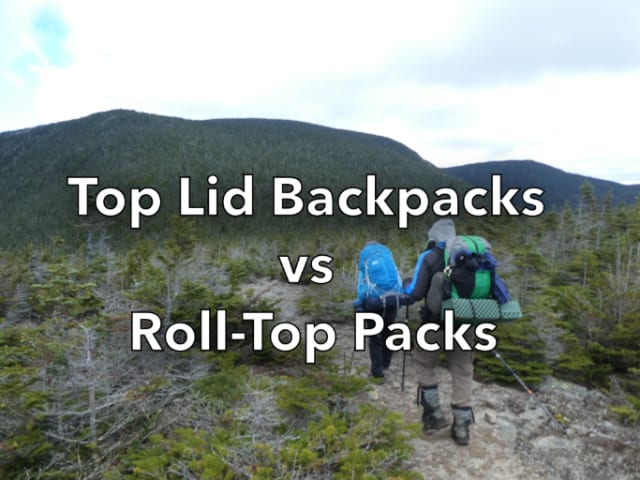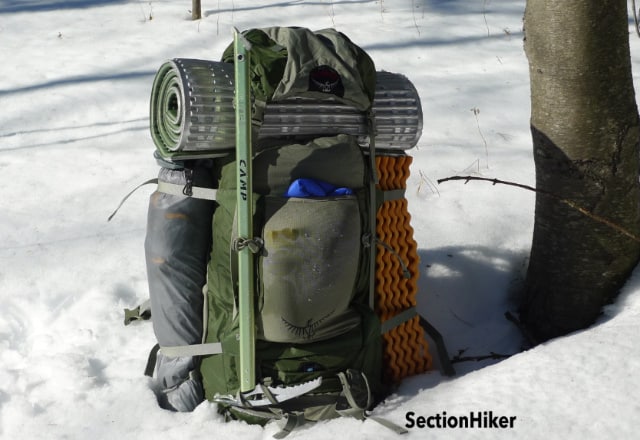
Most overnight and multi-day backpacks have either a top lid pocket or a roll-top closure. Both are perfectly fine for backpacking and which you choose has a lot to do with your personal preferences, packing style, and the type and quantity of gear you need to carry.
However, an increasing number of backpacks are available that come with optional top lids and roll-top closures giving you the best of both worlds, and more flexibility in the types of trips and loads you can carry. Some backpack designers have also broken out of the top lid/roll top paradigm completely. We’ll examine the strengths and weaknesses of each type below, so you can decide what’s best for you.
Top Lids
A top lid is a flap of fabric, often augmented with a zippered pocket that is designed to cover the hole at the top of a backpack’s main compartment, called a pack-bag. Some top lids have a pocket on the top and the bottom to provide even more gear storage and organization. These pockets are very handy for storing frequently accessed items like maps, navigation aids, gloves, hats, toiletry, and snacks and protect them from dust and moisture. They’re particularly useful in colder weather when frequent hat and glove changes are necessary or for traveling for easy access to travel documents and personal accessories.

There are two basic types of top lids:
- Top lids attached to a pack with short webbing straps or ones that are sewn on above the shoulder straps.
- Floating top lids attached to a pack with four long webbing straps that can be used to pack extra gear that won’t fit inside a pack.
Top lids sewn attached to a pack with short webbing straps or sewn-on, are typically found on lower volume day packs and backpacks under 50L-60L in volume. They act like a hinged hatch and prevent dust or moisture from falling through the top of the pack-bag, which is usually cinched closed with a drawstring.

Floating top lids are often found on higher volume packs from around 50L up to 110L. In addition to pockets, they can be used to carry bulky gear on top of the main pack-bag that can’t fit inside a backpack like bear canisters, rope coils, large tent bodies, and sleeping bags. To use them, you loosen the webbing straps, put your gear under the lid, and then tighten the webbing straps so they hold the gear in place. Packs with floating lids are useful for winter hiking and mountaineering or wilderness backpacking when you have to carry more gear, insulation, or food without frequent resupplies.
Roll Tops
Roll-top backpacks close by rolling the excess fabric at the top of the pack bag down upon itself. Another way of thinking about them is as “lid-less” backpacks that don’t have a drawstring on top. As a result, they don’t provide the extra closed storage or carrying capacity of top lids, although they do provide an extra level of top-down compression which can be useful for shrinking excess pack volume.

Roll tops were made popular by ultralight backpack makers because they’re lighter weight and much easier to manufacture than top lids. The people who use them also tend to carry a lot less gear and supplies, particularly on long-distance hiking trails where there are frequent resupply stops. Roll tops usually have fewer external straps which can simplify their use. Finally, roll tops let you “shrink” the unused capacity in the main pack-bag more effectively than a backpack with a top lid, which has a more “defined” shape and is harder to collapse when all of its capacity isn’t needed.

The sides of a roll-top pack often have buckles that attach to webbing straps anchors on the side of a pack or clip together on top of the pack. Most also come with a top strap or a Y-trap so you can attach a foam pad or drape a rope over the top of the pack bag and hold it in place. These straps let you strap awkwardly shaped gear to the top of the pack like bear canisters, foam pads, or rope coils but lack the extra pockets provided by a top lid.
Most roll-top backpacks offset the lack of a top lid pocket by having lots of open external pockets, such as the ubiquitous mesh front pocket and side water bottle pockets found on most roll-top packs. These extra pockets are good for storing items that are impervious to rain or dust, like water bottles, cooking pots, tent poles, packaged snacks, and so forth. Any items that can’t get wet or dirty, have to go inside the main pack-bag.
Packs with Top Lids and Roll Tops
If you can’t decide if you prefer a backpack with a top lid or a roll-top, you can buy a backpack that comes with a roll-top and an optional top lid when you need it.
For instance, the following backpacks are roll tops but come with optional floating lids w/pockets that can be used when you need them to haul extra gear.
- Granite Gear Crown 3 60 (men’s)
- Granite Gear Crown 3 60 (women’s)
- Granite Gear Blaze 60 (men’s)
- Granite Gear Blaze 60 (women’s)
- REI Flash 55 (pre-2024) (men’s)
- REI Flash 55 (pre-2024 (women’s)
For example, I frequently use the Granite Gear Crown 2 38 (no longer made) without a top lid as a backpack for trips during summer and autumn and only add the top lid for winter hiking when I want more accessible storage hats, gloves, and snacks.
Packs with Roll Tops and ‘Speed Lids’
Some backpacks come with top lid pockets that can be removed and replaced with a speed lid, which is simple flap that used to cover the top hole in the extension collar and prevent rain and dust from entering. For example, the Osprey Exos and Osprey Atmos both come with a flap of fabric (called a Flap Jacket) that is used to cover the pack-bag’s drawstring closure if you remove their top lid. This is intended primarily for weight reduction and is a good way to discard extra “floppy” storage when it’s not needed.
After-Market Top Lids
If you already own a roll-top backpack but want to add a top lid, several companies sell accessory floating lids that you can attach to your backpack. Zpacks sells a Multi-pack that can be used as a top pocket or floating lid. It works best with Zpack’s backpacks, but you can probably make it work with others with a few cordlocks and some ingenuity.
Non-Traditional Lids
Some backpack manufacturers make packs that have non-traditional lids and pack bag closures. For example, Gossamer Gear uses an Over-the-Top flap on the Mariposa Backpack that covers the top of the pack-bag but is sewn onto the pack-bag in front and has a zippered map pocket inside it for storage.

The Sierra Designs Flex Capacitor also has a non-traditional flip-up hatch that seals the top of the pack bag but does not have a top lid pocket. Both of these packs are simpler than a roll-top closure but lack the ability to carry much extra gear like a more traditional top lid.
SectionHiker is reader-supported. We only make money if you purchase a product through our affiliate links. Help us continue to test and write unsponsored and independent gear reviews, beginner FAQs, and free hiking guides. SectionHiker.com Backpacking Gear Reviews and FAQs
SectionHiker.com Backpacking Gear Reviews and FAQs
Good article! If on a longer hike, I will sometimes start with a lid, and as the weather warms up and gear decreases, I will send it home and just go with the roll top. When I hiked the CDT I had A TON of maps. It was good to have the lid on my Osprey so I could grab them quickly.
I have always made good use of the top lid pocket since it conveniently groups all the small stuff I might need from time to time but don’t need to unload to set up camp…along the lines of first aid and repair kits and other miscellany. The problem with these lids is that when loaded with some stuff they become a floppy inconvenience when you need to get stuff inside the pack since the lid pocket is now typically upside down and backwards.
My Baltoro 70 pack is on the larger side so I have never needed to use the lid to strap down gear. The only significant thing apart from water bottles and trekking poles I remember strapping on the outside was a self inflating sleeping pad back when they were a thing and there are other straps that worked for that. I have used it as a temporary place to stow a jacket for which is it very convenient. For that reason alone I might prefer having a some kind of strapped lid rather than a plain roll top.
I’m trying out a 40-60 Flex Capacitor which has a zipped lid and only has a very cursory lid pocket so I’ll probably have to use a stuff stack as a “ditty bag” and disrobed jackets will have to be accommodated some other way. It has plenty of straps but it is lacking external loops in convenient places like the top! They also missed a trick by not putting a pocket on the inside of the lid that opens from the top when lid is folded back. I may sew some loops on the inside of the lid to attach something but I’m finding the pack’s sizing a bit odd so I may not keep it.
As an aside, last year I started using a Zpacks mutlipack as a front “emergency chute” pack and found it to be very convenient for all the things I need when actually hiking… phone sunglasses money snacks etc. and quickly detachable to use as day “satchel” when it can hold a lunch, and to detach “valuables” from the main pack when I need to leave it somewhere in “civilization” My pack has very vestigial belt pockets and that was the motivation but I’m sold on the front pack idea even if it does involve undoing a couple of extra snaps to take my pack off. I used a 4 point connection rather than the 2 point that Zpacks suggests. Given the choice I would use it this way rather than as a “lid pocket” although obviously you don’t have to commit to that…great little auxiliary bag to have along.
I looked at replacing my pack’s “brain” with the Mountain Laurel Designs one but it only saves 2.5-3 oz so I don’t see that as worthwhile currently. The Flex Capacitor will save 3#, if it works.
I like the flexibility in capacity that the rolltop design offers. Both in the increase and decrease in size.
Bought my first roll-top several years ago and never looked back. Just love that I can shrink it down as my pack grows smaller over the course of a trip. It also forces me to think about being somewhat minimalist in my packing. Love my Granite Gear and my ULA.
Hey Vince – got a big Osprey when we hiked together years ago after seeing your gear. Now on the lightweight program and I too love my Granite Gear with the optional top lid.
I use the zpack multipacks on both my arc and my ULA Photon.